NURSING: Reflective Essay on Health Beliefs about Eating Habits
VerifiedAdded on 2023/04/11
|11
|2391
|234
Essay
AI Summary
This essay is a reflection on personal health beliefs related to nutrition and eating patterns, examining healthy and risky behaviors through the lens of the Health Belief Model. It delves into factors influencing these beliefs, such as cultural norms and evidence-based research, and explores strategies for engaging in conversations with clients holding differing views. The reflection covers topics like the impact of portion sizes, the dangers of excessive alcohol consumption, and the risks associated with consuming raw or undercooked foods. The author also analyzes how personal values, cultural influences, and awareness of nutritional diseases have shaped their health beliefs, emphasizing the importance of evidence-based resources and culturally sensitive communication in promoting healthy dietary habits.
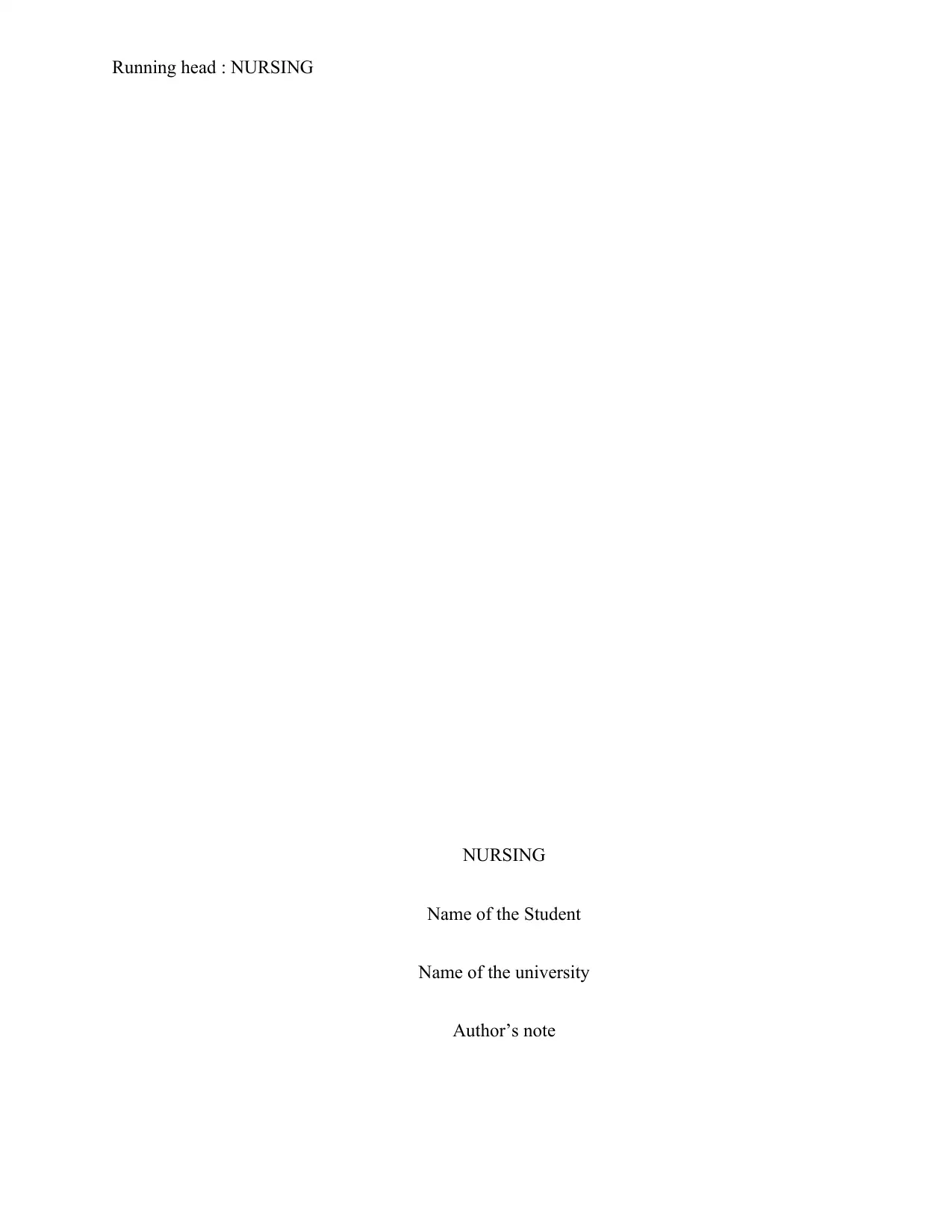
Running head : NURSING
NURSING
Name of the Student
Name of the university
Author’s note
NURSING
Name of the Student
Name of the university
Author’s note
Paraphrase This Document
Need a fresh take? Get an instant paraphrase of this document with our AI Paraphraser
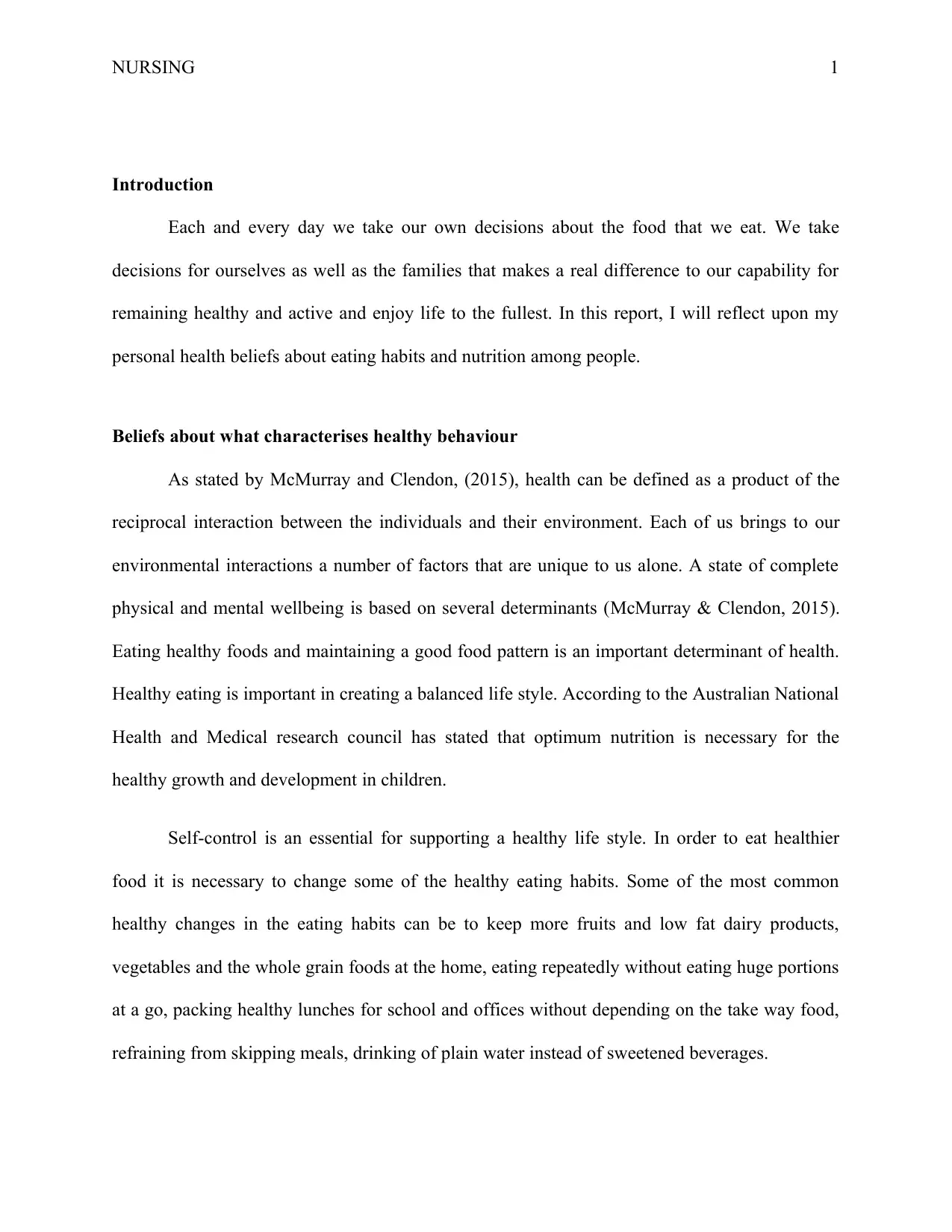
NURSING 1
Introduction
Each and every day we take our own decisions about the food that we eat. We take
decisions for ourselves as well as the families that makes a real difference to our capability for
remaining healthy and active and enjoy life to the fullest. In this report, I will reflect upon my
personal health beliefs about eating habits and nutrition among people.
Beliefs about what characterises healthy behaviour
As stated by McMurray and Clendon, (2015), health can be defined as a product of the
reciprocal interaction between the individuals and their environment. Each of us brings to our
environmental interactions a number of factors that are unique to us alone. A state of complete
physical and mental wellbeing is based on several determinants (McMurray & Clendon, 2015).
Eating healthy foods and maintaining a good food pattern is an important determinant of health.
Healthy eating is important in creating a balanced life style. According to the Australian National
Health and Medical research council has stated that optimum nutrition is necessary for the
healthy growth and development in children.
Self-control is an essential for supporting a healthy life style. In order to eat healthier
food it is necessary to change some of the healthy eating habits. Some of the most common
healthy changes in the eating habits can be to keep more fruits and low fat dairy products,
vegetables and the whole grain foods at the home, eating repeatedly without eating huge portions
at a go, packing healthy lunches for school and offices without depending on the take way food,
refraining from skipping meals, drinking of plain water instead of sweetened beverages.
Introduction
Each and every day we take our own decisions about the food that we eat. We take
decisions for ourselves as well as the families that makes a real difference to our capability for
remaining healthy and active and enjoy life to the fullest. In this report, I will reflect upon my
personal health beliefs about eating habits and nutrition among people.
Beliefs about what characterises healthy behaviour
As stated by McMurray and Clendon, (2015), health can be defined as a product of the
reciprocal interaction between the individuals and their environment. Each of us brings to our
environmental interactions a number of factors that are unique to us alone. A state of complete
physical and mental wellbeing is based on several determinants (McMurray & Clendon, 2015).
Eating healthy foods and maintaining a good food pattern is an important determinant of health.
Healthy eating is important in creating a balanced life style. According to the Australian National
Health and Medical research council has stated that optimum nutrition is necessary for the
healthy growth and development in children.
Self-control is an essential for supporting a healthy life style. In order to eat healthier
food it is necessary to change some of the healthy eating habits. Some of the most common
healthy changes in the eating habits can be to keep more fruits and low fat dairy products,
vegetables and the whole grain foods at the home, eating repeatedly without eating huge portions
at a go, packing healthy lunches for school and offices without depending on the take way food,
refraining from skipping meals, drinking of plain water instead of sweetened beverages.
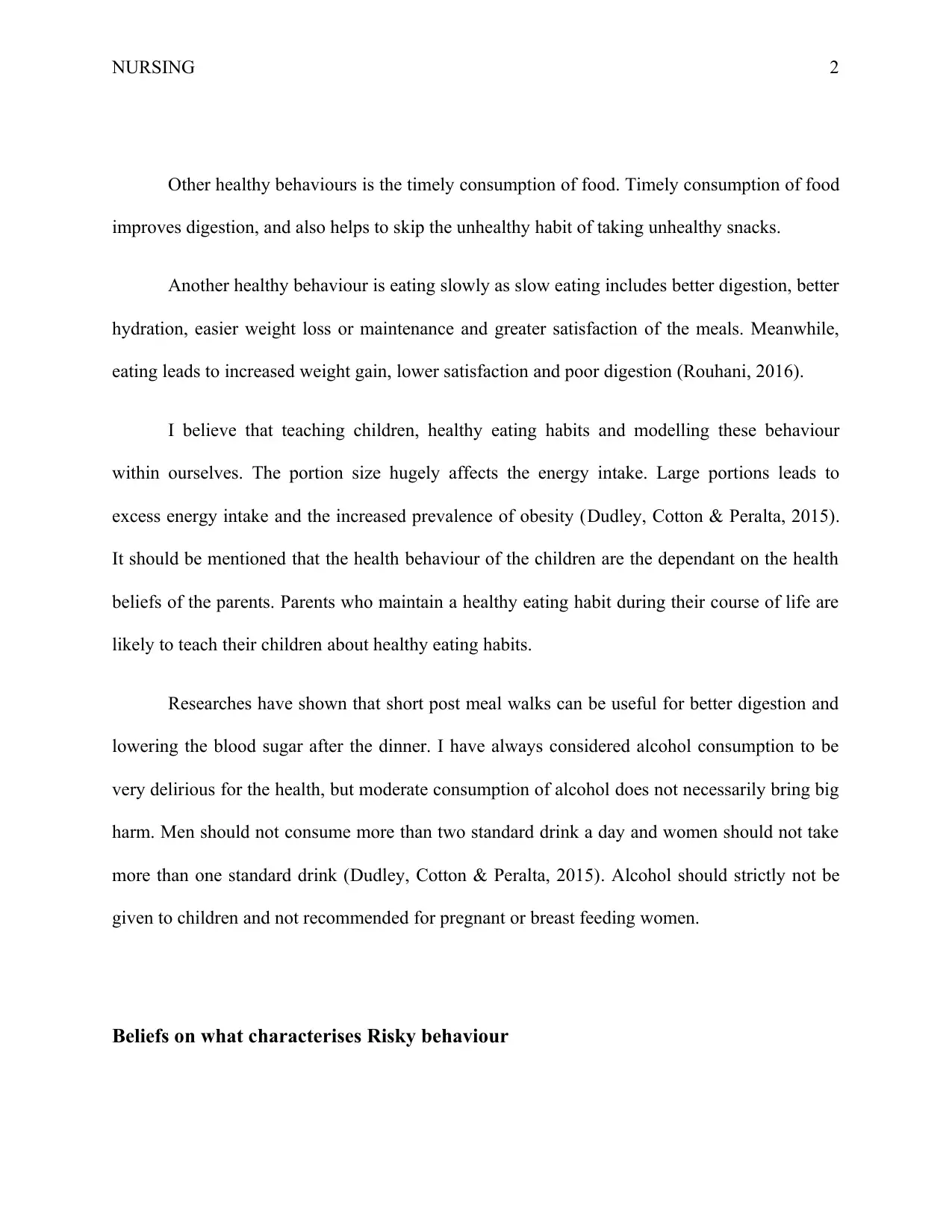
NURSING 2
Other healthy behaviours is the timely consumption of food. Timely consumption of food
improves digestion, and also helps to skip the unhealthy habit of taking unhealthy snacks.
Another healthy behaviour is eating slowly as slow eating includes better digestion, better
hydration, easier weight loss or maintenance and greater satisfaction of the meals. Meanwhile,
eating leads to increased weight gain, lower satisfaction and poor digestion (Rouhani, 2016).
I believe that teaching children, healthy eating habits and modelling these behaviour
within ourselves. The portion size hugely affects the energy intake. Large portions leads to
excess energy intake and the increased prevalence of obesity (Dudley, Cotton & Peralta, 2015).
It should be mentioned that the health behaviour of the children are the dependant on the health
beliefs of the parents. Parents who maintain a healthy eating habit during their course of life are
likely to teach their children about healthy eating habits.
Researches have shown that short post meal walks can be useful for better digestion and
lowering the blood sugar after the dinner. I have always considered alcohol consumption to be
very delirious for the health, but moderate consumption of alcohol does not necessarily bring big
harm. Men should not consume more than two standard drink a day and women should not take
more than one standard drink (Dudley, Cotton & Peralta, 2015). Alcohol should strictly not be
given to children and not recommended for pregnant or breast feeding women.
Beliefs on what characterises Risky behaviour
Other healthy behaviours is the timely consumption of food. Timely consumption of food
improves digestion, and also helps to skip the unhealthy habit of taking unhealthy snacks.
Another healthy behaviour is eating slowly as slow eating includes better digestion, better
hydration, easier weight loss or maintenance and greater satisfaction of the meals. Meanwhile,
eating leads to increased weight gain, lower satisfaction and poor digestion (Rouhani, 2016).
I believe that teaching children, healthy eating habits and modelling these behaviour
within ourselves. The portion size hugely affects the energy intake. Large portions leads to
excess energy intake and the increased prevalence of obesity (Dudley, Cotton & Peralta, 2015).
It should be mentioned that the health behaviour of the children are the dependant on the health
beliefs of the parents. Parents who maintain a healthy eating habit during their course of life are
likely to teach their children about healthy eating habits.
Researches have shown that short post meal walks can be useful for better digestion and
lowering the blood sugar after the dinner. I have always considered alcohol consumption to be
very delirious for the health, but moderate consumption of alcohol does not necessarily bring big
harm. Men should not consume more than two standard drink a day and women should not take
more than one standard drink (Dudley, Cotton & Peralta, 2015). Alcohol should strictly not be
given to children and not recommended for pregnant or breast feeding women.
Beliefs on what characterises Risky behaviour
⊘ This is a preview!⊘
Do you want full access?
Subscribe today to unlock all pages.

Trusted by 1+ million students worldwide
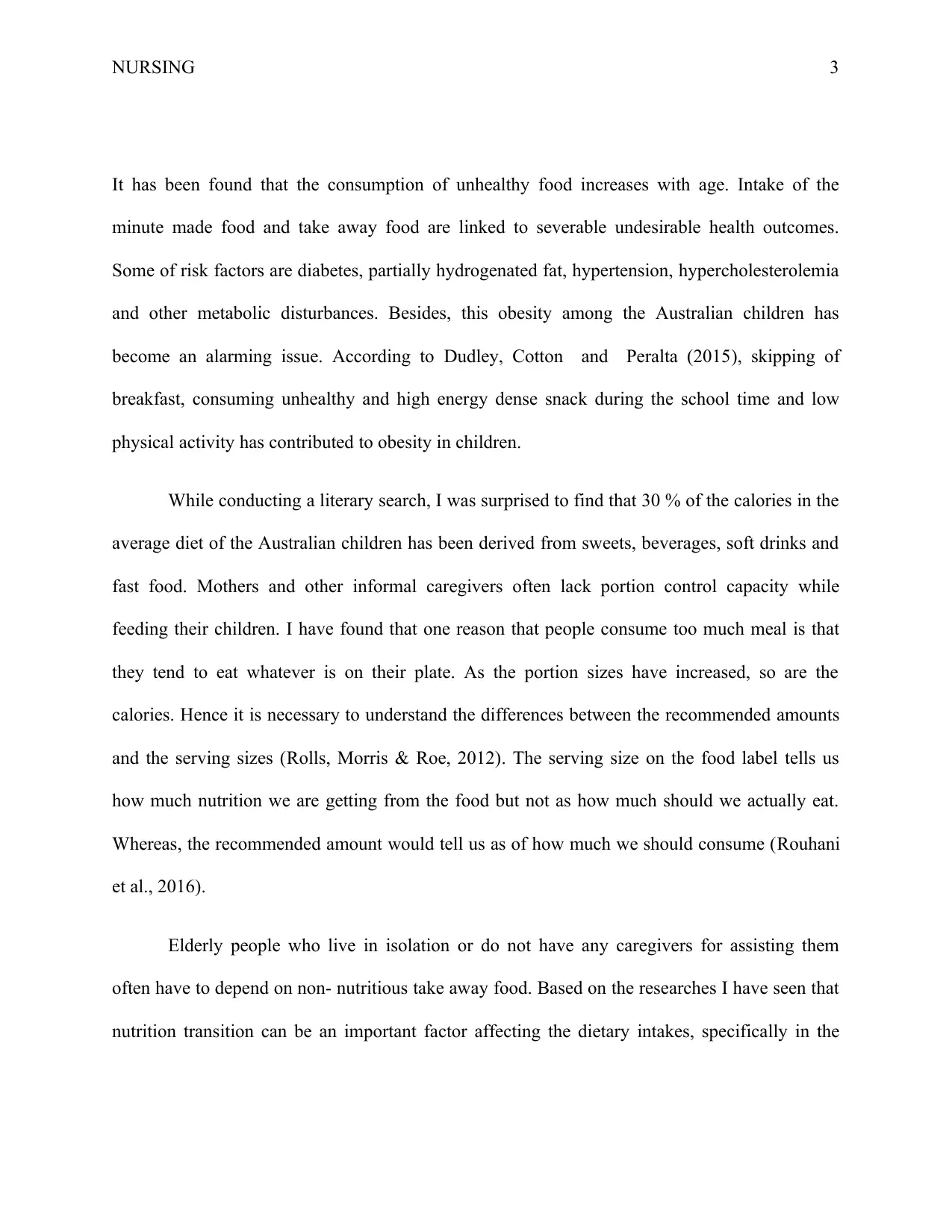
NURSING 3
It has been found that the consumption of unhealthy food increases with age. Intake of the
minute made food and take away food are linked to severable undesirable health outcomes.
Some of risk factors are diabetes, partially hydrogenated fat, hypertension, hypercholesterolemia
and other metabolic disturbances. Besides, this obesity among the Australian children has
become an alarming issue. According to Dudley, Cotton and Peralta (2015), skipping of
breakfast, consuming unhealthy and high energy dense snack during the school time and low
physical activity has contributed to obesity in children.
While conducting a literary search, I was surprised to find that 30 % of the calories in the
average diet of the Australian children has been derived from sweets, beverages, soft drinks and
fast food. Mothers and other informal caregivers often lack portion control capacity while
feeding their children. I have found that one reason that people consume too much meal is that
they tend to eat whatever is on their plate. As the portion sizes have increased, so are the
calories. Hence it is necessary to understand the differences between the recommended amounts
and the serving sizes (Rolls, Morris & Roe, 2012). The serving size on the food label tells us
how much nutrition we are getting from the food but not as how much should we actually eat.
Whereas, the recommended amount would tell us as of how much we should consume (Rouhani
et al., 2016).
Elderly people who live in isolation or do not have any caregivers for assisting them
often have to depend on non- nutritious take away food. Based on the researches I have seen that
nutrition transition can be an important factor affecting the dietary intakes, specifically in the
It has been found that the consumption of unhealthy food increases with age. Intake of the
minute made food and take away food are linked to severable undesirable health outcomes.
Some of risk factors are diabetes, partially hydrogenated fat, hypertension, hypercholesterolemia
and other metabolic disturbances. Besides, this obesity among the Australian children has
become an alarming issue. According to Dudley, Cotton and Peralta (2015), skipping of
breakfast, consuming unhealthy and high energy dense snack during the school time and low
physical activity has contributed to obesity in children.
While conducting a literary search, I was surprised to find that 30 % of the calories in the
average diet of the Australian children has been derived from sweets, beverages, soft drinks and
fast food. Mothers and other informal caregivers often lack portion control capacity while
feeding their children. I have found that one reason that people consume too much meal is that
they tend to eat whatever is on their plate. As the portion sizes have increased, so are the
calories. Hence it is necessary to understand the differences between the recommended amounts
and the serving sizes (Rolls, Morris & Roe, 2012). The serving size on the food label tells us
how much nutrition we are getting from the food but not as how much should we actually eat.
Whereas, the recommended amount would tell us as of how much we should consume (Rouhani
et al., 2016).
Elderly people who live in isolation or do not have any caregivers for assisting them
often have to depend on non- nutritious take away food. Based on the researches I have seen that
nutrition transition can be an important factor affecting the dietary intakes, specifically in the
Paraphrase This Document
Need a fresh take? Get an instant paraphrase of this document with our AI Paraphraser
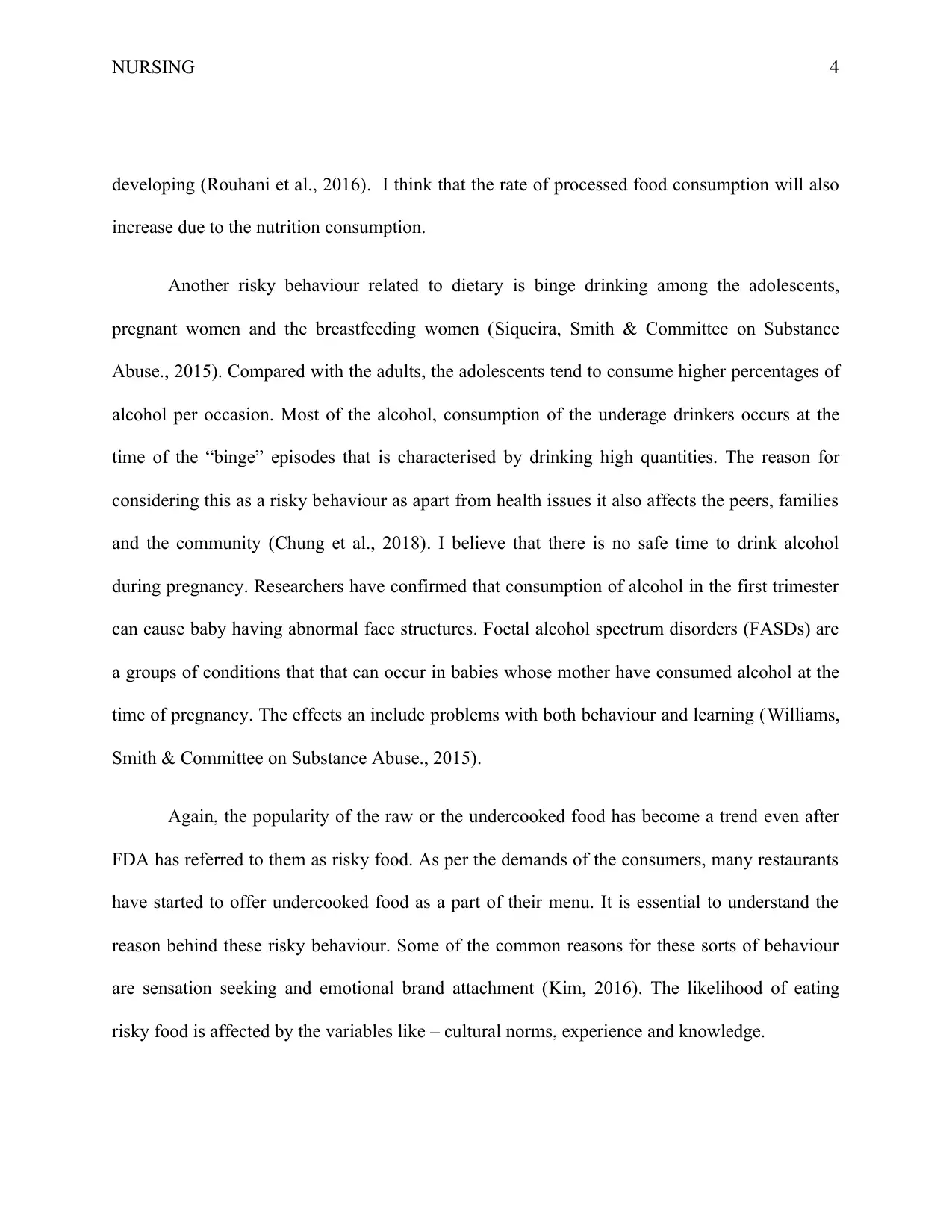
NURSING 4
developing (Rouhani et al., 2016). I think that the rate of processed food consumption will also
increase due to the nutrition consumption.
Another risky behaviour related to dietary is binge drinking among the adolescents,
pregnant women and the breastfeeding women (Siqueira, Smith & Committee on Substance
Abuse., 2015). Compared with the adults, the adolescents tend to consume higher percentages of
alcohol per occasion. Most of the alcohol, consumption of the underage drinkers occurs at the
time of the “binge” episodes that is characterised by drinking high quantities. The reason for
considering this as a risky behaviour as apart from health issues it also affects the peers, families
and the community (Chung et al., 2018). I believe that there is no safe time to drink alcohol
during pregnancy. Researchers have confirmed that consumption of alcohol in the first trimester
can cause baby having abnormal face structures. Foetal alcohol spectrum disorders (FASDs) are
a groups of conditions that that can occur in babies whose mother have consumed alcohol at the
time of pregnancy. The effects an include problems with both behaviour and learning (Williams,
Smith & Committee on Substance Abuse., 2015).
Again, the popularity of the raw or the undercooked food has become a trend even after
FDA has referred to them as risky food. As per the demands of the consumers, many restaurants
have started to offer undercooked food as a part of their menu. It is essential to understand the
reason behind these risky behaviour. Some of the common reasons for these sorts of behaviour
are sensation seeking and emotional brand attachment (Kim, 2016). The likelihood of eating
risky food is affected by the variables like – cultural norms, experience and knowledge.
developing (Rouhani et al., 2016). I think that the rate of processed food consumption will also
increase due to the nutrition consumption.
Another risky behaviour related to dietary is binge drinking among the adolescents,
pregnant women and the breastfeeding women (Siqueira, Smith & Committee on Substance
Abuse., 2015). Compared with the adults, the adolescents tend to consume higher percentages of
alcohol per occasion. Most of the alcohol, consumption of the underage drinkers occurs at the
time of the “binge” episodes that is characterised by drinking high quantities. The reason for
considering this as a risky behaviour as apart from health issues it also affects the peers, families
and the community (Chung et al., 2018). I believe that there is no safe time to drink alcohol
during pregnancy. Researchers have confirmed that consumption of alcohol in the first trimester
can cause baby having abnormal face structures. Foetal alcohol spectrum disorders (FASDs) are
a groups of conditions that that can occur in babies whose mother have consumed alcohol at the
time of pregnancy. The effects an include problems with both behaviour and learning (Williams,
Smith & Committee on Substance Abuse., 2015).
Again, the popularity of the raw or the undercooked food has become a trend even after
FDA has referred to them as risky food. As per the demands of the consumers, many restaurants
have started to offer undercooked food as a part of their menu. It is essential to understand the
reason behind these risky behaviour. Some of the common reasons for these sorts of behaviour
are sensation seeking and emotional brand attachment (Kim, 2016). The likelihood of eating
risky food is affected by the variables like – cultural norms, experience and knowledge.
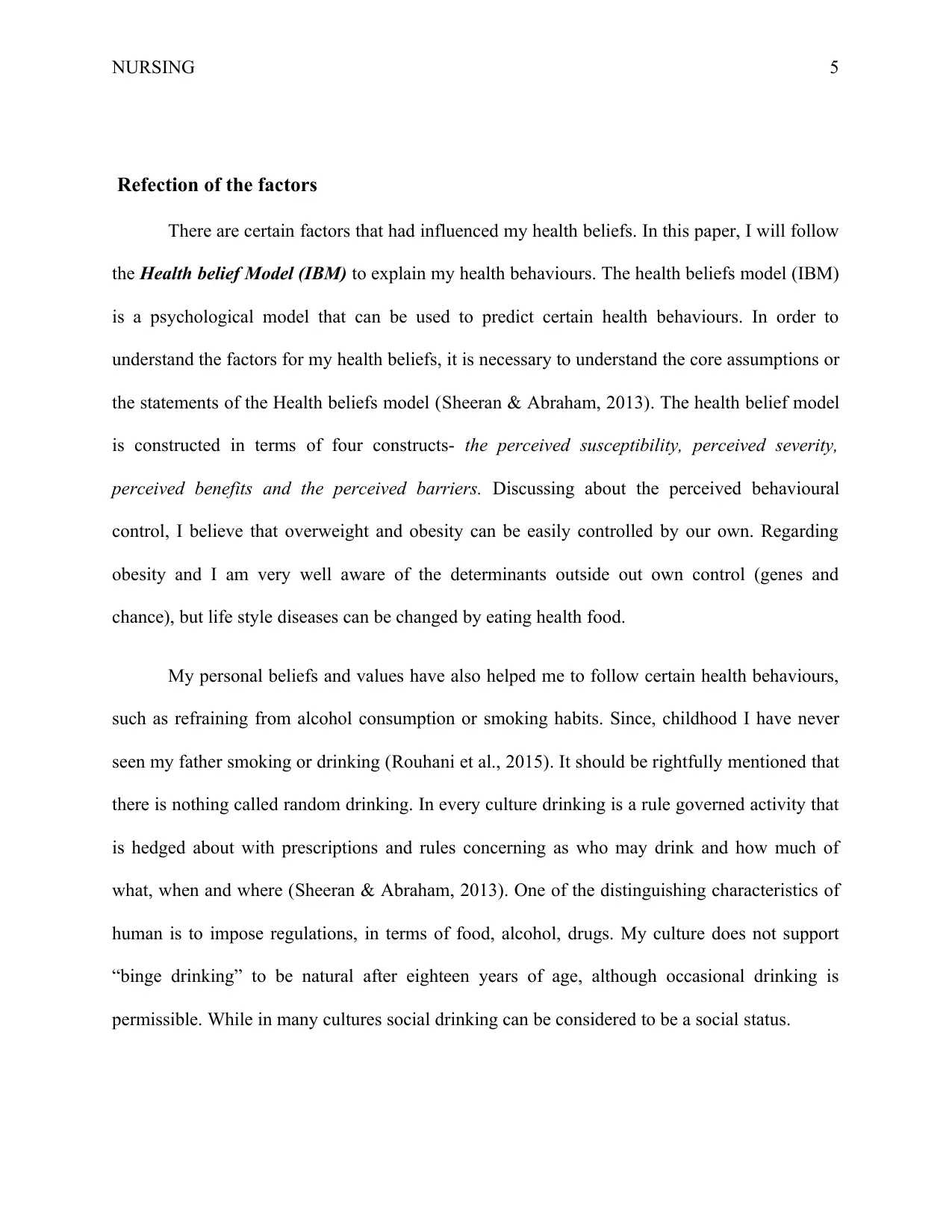
NURSING 5
Refection of the factors
There are certain factors that had influenced my health beliefs. In this paper, I will follow
the Health belief Model (IBM) to explain my health behaviours. The health beliefs model (IBM)
is a psychological model that can be used to predict certain health behaviours. In order to
understand the factors for my health beliefs, it is necessary to understand the core assumptions or
the statements of the Health beliefs model (Sheeran & Abraham, 2013). The health belief model
is constructed in terms of four constructs- the perceived susceptibility, perceived severity,
perceived benefits and the perceived barriers. Discussing about the perceived behavioural
control, I believe that overweight and obesity can be easily controlled by our own. Regarding
obesity and I am very well aware of the determinants outside out own control (genes and
chance), but life style diseases can be changed by eating health food.
My personal beliefs and values have also helped me to follow certain health behaviours,
such as refraining from alcohol consumption or smoking habits. Since, childhood I have never
seen my father smoking or drinking (Rouhani et al., 2015). It should be rightfully mentioned that
there is nothing called random drinking. In every culture drinking is a rule governed activity that
is hedged about with prescriptions and rules concerning as who may drink and how much of
what, when and where (Sheeran & Abraham, 2013). One of the distinguishing characteristics of
human is to impose regulations, in terms of food, alcohol, drugs. My culture does not support
“binge drinking” to be natural after eighteen years of age, although occasional drinking is
permissible. While in many cultures social drinking can be considered to be a social status.
Refection of the factors
There are certain factors that had influenced my health beliefs. In this paper, I will follow
the Health belief Model (IBM) to explain my health behaviours. The health beliefs model (IBM)
is a psychological model that can be used to predict certain health behaviours. In order to
understand the factors for my health beliefs, it is necessary to understand the core assumptions or
the statements of the Health beliefs model (Sheeran & Abraham, 2013). The health belief model
is constructed in terms of four constructs- the perceived susceptibility, perceived severity,
perceived benefits and the perceived barriers. Discussing about the perceived behavioural
control, I believe that overweight and obesity can be easily controlled by our own. Regarding
obesity and I am very well aware of the determinants outside out own control (genes and
chance), but life style diseases can be changed by eating health food.
My personal beliefs and values have also helped me to follow certain health behaviours,
such as refraining from alcohol consumption or smoking habits. Since, childhood I have never
seen my father smoking or drinking (Rouhani et al., 2015). It should be rightfully mentioned that
there is nothing called random drinking. In every culture drinking is a rule governed activity that
is hedged about with prescriptions and rules concerning as who may drink and how much of
what, when and where (Sheeran & Abraham, 2013). One of the distinguishing characteristics of
human is to impose regulations, in terms of food, alcohol, drugs. My culture does not support
“binge drinking” to be natural after eighteen years of age, although occasional drinking is
permissible. While in many cultures social drinking can be considered to be a social status.
⊘ This is a preview!⊘
Do you want full access?
Subscribe today to unlock all pages.

Trusted by 1+ million students worldwide
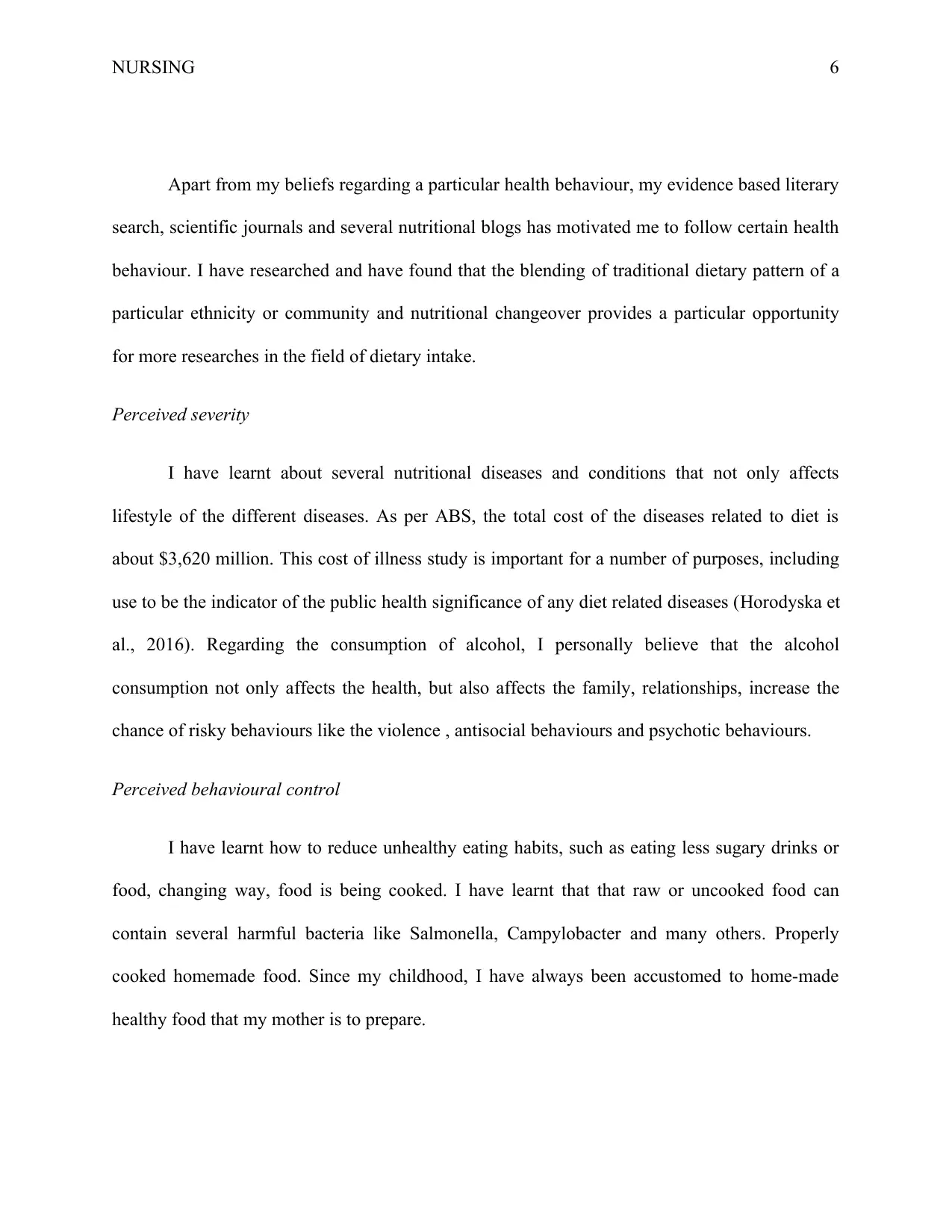
NURSING 6
Apart from my beliefs regarding a particular health behaviour, my evidence based literary
search, scientific journals and several nutritional blogs has motivated me to follow certain health
behaviour. I have researched and have found that the blending of traditional dietary pattern of a
particular ethnicity or community and nutritional changeover provides a particular opportunity
for more researches in the field of dietary intake.
Perceived severity
I have learnt about several nutritional diseases and conditions that not only affects
lifestyle of the different diseases. As per ABS, the total cost of the diseases related to diet is
about $3,620 million. This cost of illness study is important for a number of purposes, including
use to be the indicator of the public health significance of any diet related diseases (Horodyska et
al., 2016). Regarding the consumption of alcohol, I personally believe that the alcohol
consumption not only affects the health, but also affects the family, relationships, increase the
chance of risky behaviours like the violence , antisocial behaviours and psychotic behaviours.
Perceived behavioural control
I have learnt how to reduce unhealthy eating habits, such as eating less sugary drinks or
food, changing way, food is being cooked. I have learnt that that raw or uncooked food can
contain several harmful bacteria like Salmonella, Campylobacter and many others. Properly
cooked homemade food. Since my childhood, I have always been accustomed to home-made
healthy food that my mother is to prepare.
Apart from my beliefs regarding a particular health behaviour, my evidence based literary
search, scientific journals and several nutritional blogs has motivated me to follow certain health
behaviour. I have researched and have found that the blending of traditional dietary pattern of a
particular ethnicity or community and nutritional changeover provides a particular opportunity
for more researches in the field of dietary intake.
Perceived severity
I have learnt about several nutritional diseases and conditions that not only affects
lifestyle of the different diseases. As per ABS, the total cost of the diseases related to diet is
about $3,620 million. This cost of illness study is important for a number of purposes, including
use to be the indicator of the public health significance of any diet related diseases (Horodyska et
al., 2016). Regarding the consumption of alcohol, I personally believe that the alcohol
consumption not only affects the health, but also affects the family, relationships, increase the
chance of risky behaviours like the violence , antisocial behaviours and psychotic behaviours.
Perceived behavioural control
I have learnt how to reduce unhealthy eating habits, such as eating less sugary drinks or
food, changing way, food is being cooked. I have learnt that that raw or uncooked food can
contain several harmful bacteria like Salmonella, Campylobacter and many others. Properly
cooked homemade food. Since my childhood, I have always been accustomed to home-made
healthy food that my mother is to prepare.
Paraphrase This Document
Need a fresh take? Get an instant paraphrase of this document with our AI Paraphraser
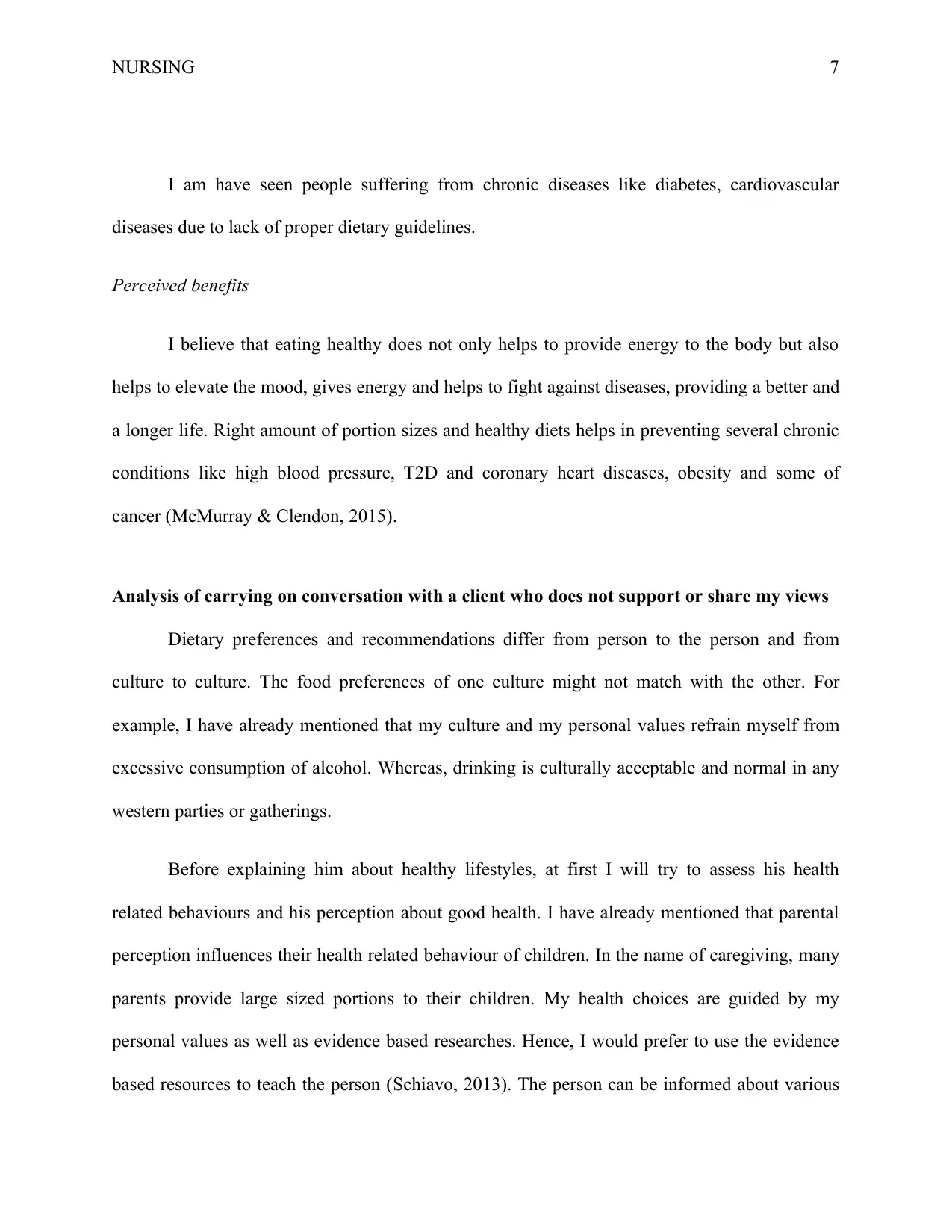
NURSING 7
I am have seen people suffering from chronic diseases like diabetes, cardiovascular
diseases due to lack of proper dietary guidelines.
Perceived benefits
I believe that eating healthy does not only helps to provide energy to the body but also
helps to elevate the mood, gives energy and helps to fight against diseases, providing a better and
a longer life. Right amount of portion sizes and healthy diets helps in preventing several chronic
conditions like high blood pressure, T2D and coronary heart diseases, obesity and some of
cancer (McMurray & Clendon, 2015).
Analysis of carrying on conversation with a client who does not support or share my views
Dietary preferences and recommendations differ from person to the person and from
culture to culture. The food preferences of one culture might not match with the other. For
example, I have already mentioned that my culture and my personal values refrain myself from
excessive consumption of alcohol. Whereas, drinking is culturally acceptable and normal in any
western parties or gatherings.
Before explaining him about healthy lifestyles, at first I will try to assess his health
related behaviours and his perception about good health. I have already mentioned that parental
perception influences their health related behaviour of children. In the name of caregiving, many
parents provide large sized portions to their children. My health choices are guided by my
personal values as well as evidence based researches. Hence, I would prefer to use the evidence
based resources to teach the person (Schiavo, 2013). The person can be informed about various
I am have seen people suffering from chronic diseases like diabetes, cardiovascular
diseases due to lack of proper dietary guidelines.
Perceived benefits
I believe that eating healthy does not only helps to provide energy to the body but also
helps to elevate the mood, gives energy and helps to fight against diseases, providing a better and
a longer life. Right amount of portion sizes and healthy diets helps in preventing several chronic
conditions like high blood pressure, T2D and coronary heart diseases, obesity and some of
cancer (McMurray & Clendon, 2015).
Analysis of carrying on conversation with a client who does not support or share my views
Dietary preferences and recommendations differ from person to the person and from
culture to culture. The food preferences of one culture might not match with the other. For
example, I have already mentioned that my culture and my personal values refrain myself from
excessive consumption of alcohol. Whereas, drinking is culturally acceptable and normal in any
western parties or gatherings.
Before explaining him about healthy lifestyles, at first I will try to assess his health
related behaviours and his perception about good health. I have already mentioned that parental
perception influences their health related behaviour of children. In the name of caregiving, many
parents provide large sized portions to their children. My health choices are guided by my
personal values as well as evidence based researches. Hence, I would prefer to use the evidence
based resources to teach the person (Schiavo, 2013). The person can be informed about various
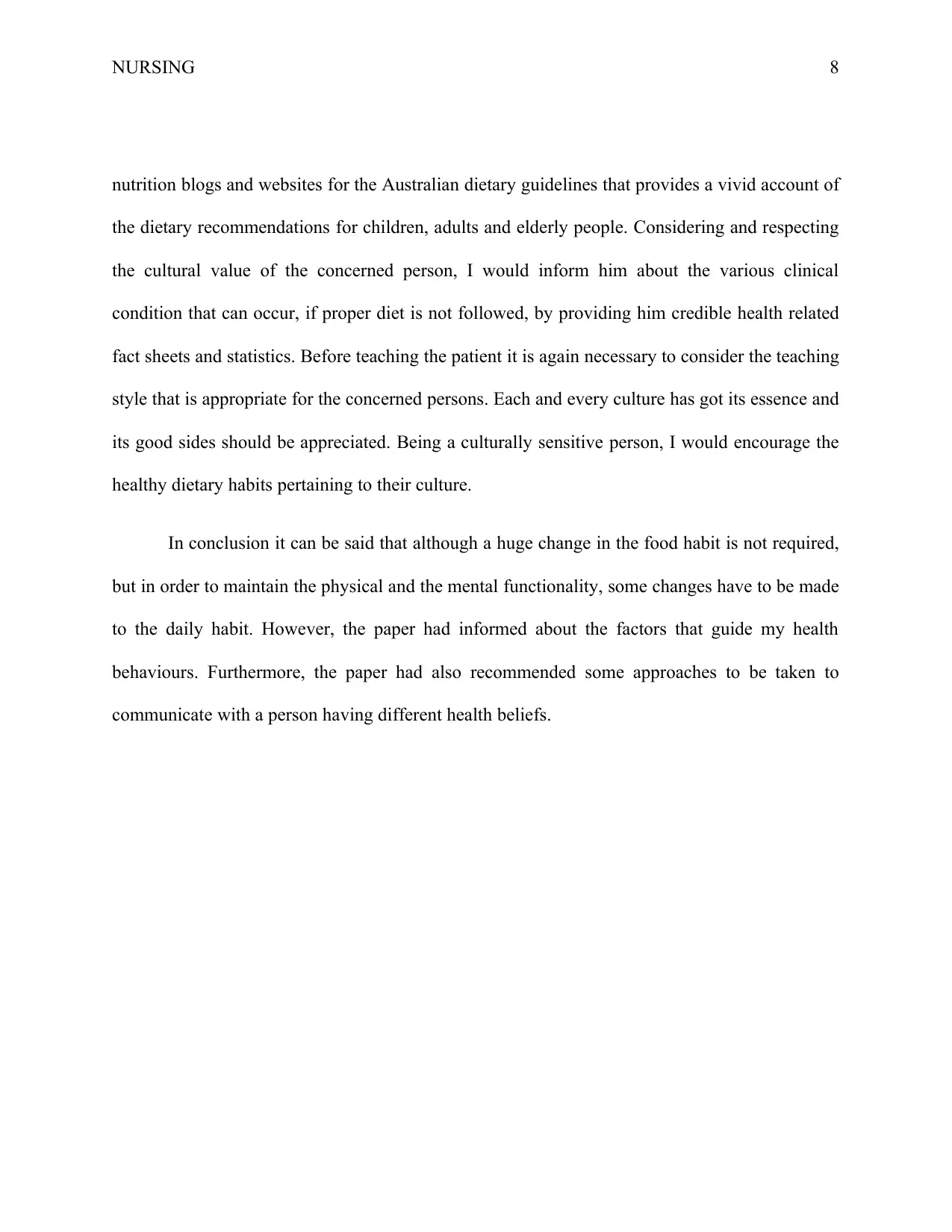
NURSING 8
nutrition blogs and websites for the Australian dietary guidelines that provides a vivid account of
the dietary recommendations for children, adults and elderly people. Considering and respecting
the cultural value of the concerned person, I would inform him about the various clinical
condition that can occur, if proper diet is not followed, by providing him credible health related
fact sheets and statistics. Before teaching the patient it is again necessary to consider the teaching
style that is appropriate for the concerned persons. Each and every culture has got its essence and
its good sides should be appreciated. Being a culturally sensitive person, I would encourage the
healthy dietary habits pertaining to their culture.
In conclusion it can be said that although a huge change in the food habit is not required,
but in order to maintain the physical and the mental functionality, some changes have to be made
to the daily habit. However, the paper had informed about the factors that guide my health
behaviours. Furthermore, the paper had also recommended some approaches to be taken to
communicate with a person having different health beliefs.
nutrition blogs and websites for the Australian dietary guidelines that provides a vivid account of
the dietary recommendations for children, adults and elderly people. Considering and respecting
the cultural value of the concerned person, I would inform him about the various clinical
condition that can occur, if proper diet is not followed, by providing him credible health related
fact sheets and statistics. Before teaching the patient it is again necessary to consider the teaching
style that is appropriate for the concerned persons. Each and every culture has got its essence and
its good sides should be appreciated. Being a culturally sensitive person, I would encourage the
healthy dietary habits pertaining to their culture.
In conclusion it can be said that although a huge change in the food habit is not required,
but in order to maintain the physical and the mental functionality, some changes have to be made
to the daily habit. However, the paper had informed about the factors that guide my health
behaviours. Furthermore, the paper had also recommended some approaches to be taken to
communicate with a person having different health beliefs.
⊘ This is a preview!⊘
Do you want full access?
Subscribe today to unlock all pages.

Trusted by 1+ million students worldwide
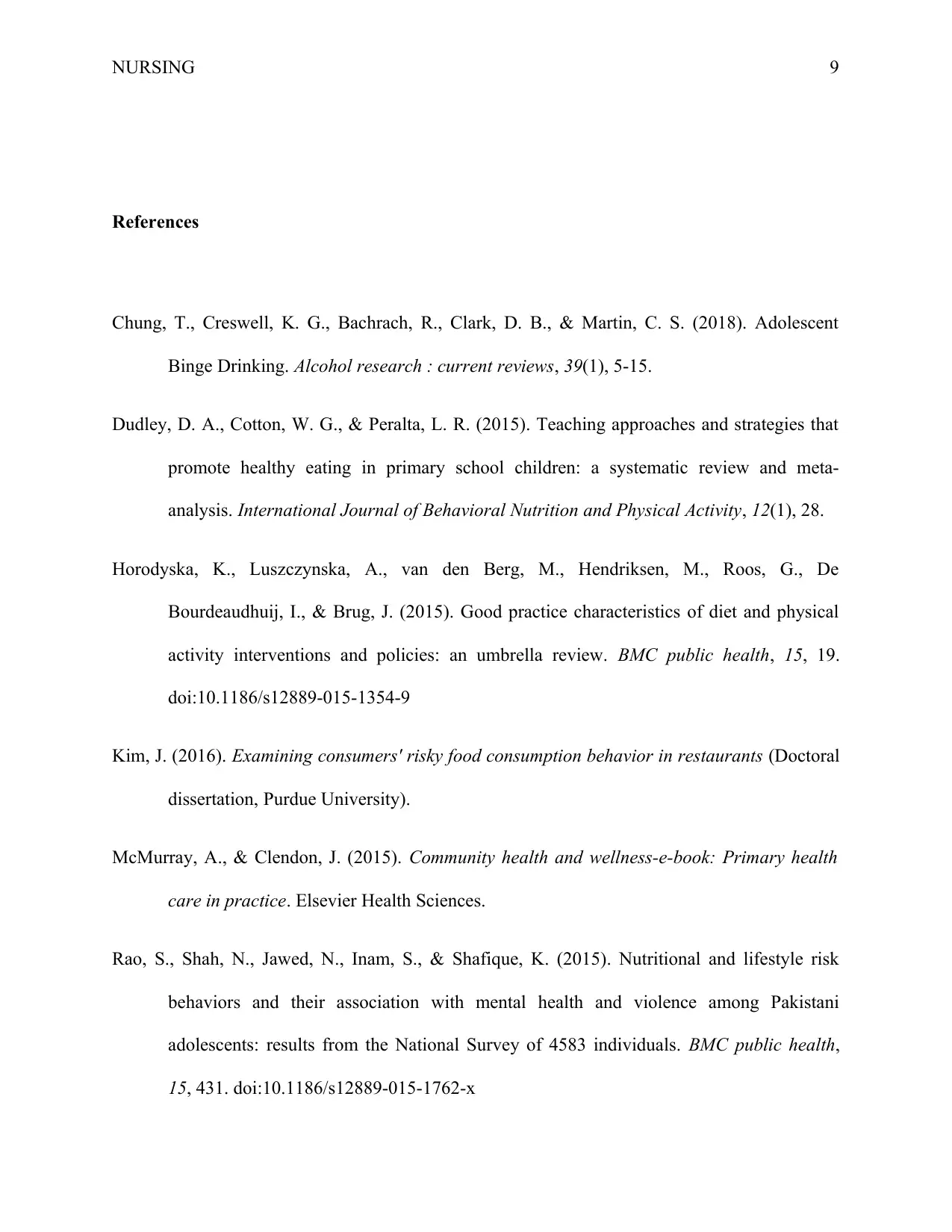
NURSING 9
References
Chung, T., Creswell, K. G., Bachrach, R., Clark, D. B., & Martin, C. S. (2018). Adolescent
Binge Drinking. Alcohol research : current reviews, 39(1), 5-15.
Dudley, D. A., Cotton, W. G., & Peralta, L. R. (2015). Teaching approaches and strategies that
promote healthy eating in primary school children: a systematic review and meta-
analysis. International Journal of Behavioral Nutrition and Physical Activity, 12(1), 28.
Horodyska, K., Luszczynska, A., van den Berg, M., Hendriksen, M., Roos, G., De
Bourdeaudhuij, I., & Brug, J. (2015). Good practice characteristics of diet and physical
activity interventions and policies: an umbrella review. BMC public health, 15, 19.
doi:10.1186/s12889-015-1354-9
Kim, J. (2016). Examining consumers' risky food consumption behavior in restaurants (Doctoral
dissertation, Purdue University).
McMurray, A., & Clendon, J. (2015). Community health and wellness-e-book: Primary health
care in practice. Elsevier Health Sciences.
Rao, S., Shah, N., Jawed, N., Inam, S., & Shafique, K. (2015). Nutritional and lifestyle risk
behaviors and their association with mental health and violence among Pakistani
adolescents: results from the National Survey of 4583 individuals. BMC public health,
15, 431. doi:10.1186/s12889-015-1762-x
References
Chung, T., Creswell, K. G., Bachrach, R., Clark, D. B., & Martin, C. S. (2018). Adolescent
Binge Drinking. Alcohol research : current reviews, 39(1), 5-15.
Dudley, D. A., Cotton, W. G., & Peralta, L. R. (2015). Teaching approaches and strategies that
promote healthy eating in primary school children: a systematic review and meta-
analysis. International Journal of Behavioral Nutrition and Physical Activity, 12(1), 28.
Horodyska, K., Luszczynska, A., van den Berg, M., Hendriksen, M., Roos, G., De
Bourdeaudhuij, I., & Brug, J. (2015). Good practice characteristics of diet and physical
activity interventions and policies: an umbrella review. BMC public health, 15, 19.
doi:10.1186/s12889-015-1354-9
Kim, J. (2016). Examining consumers' risky food consumption behavior in restaurants (Doctoral
dissertation, Purdue University).
McMurray, A., & Clendon, J. (2015). Community health and wellness-e-book: Primary health
care in practice. Elsevier Health Sciences.
Rao, S., Shah, N., Jawed, N., Inam, S., & Shafique, K. (2015). Nutritional and lifestyle risk
behaviors and their association with mental health and violence among Pakistani
adolescents: results from the National Survey of 4583 individuals. BMC public health,
15, 431. doi:10.1186/s12889-015-1762-x
Paraphrase This Document
Need a fresh take? Get an instant paraphrase of this document with our AI Paraphraser
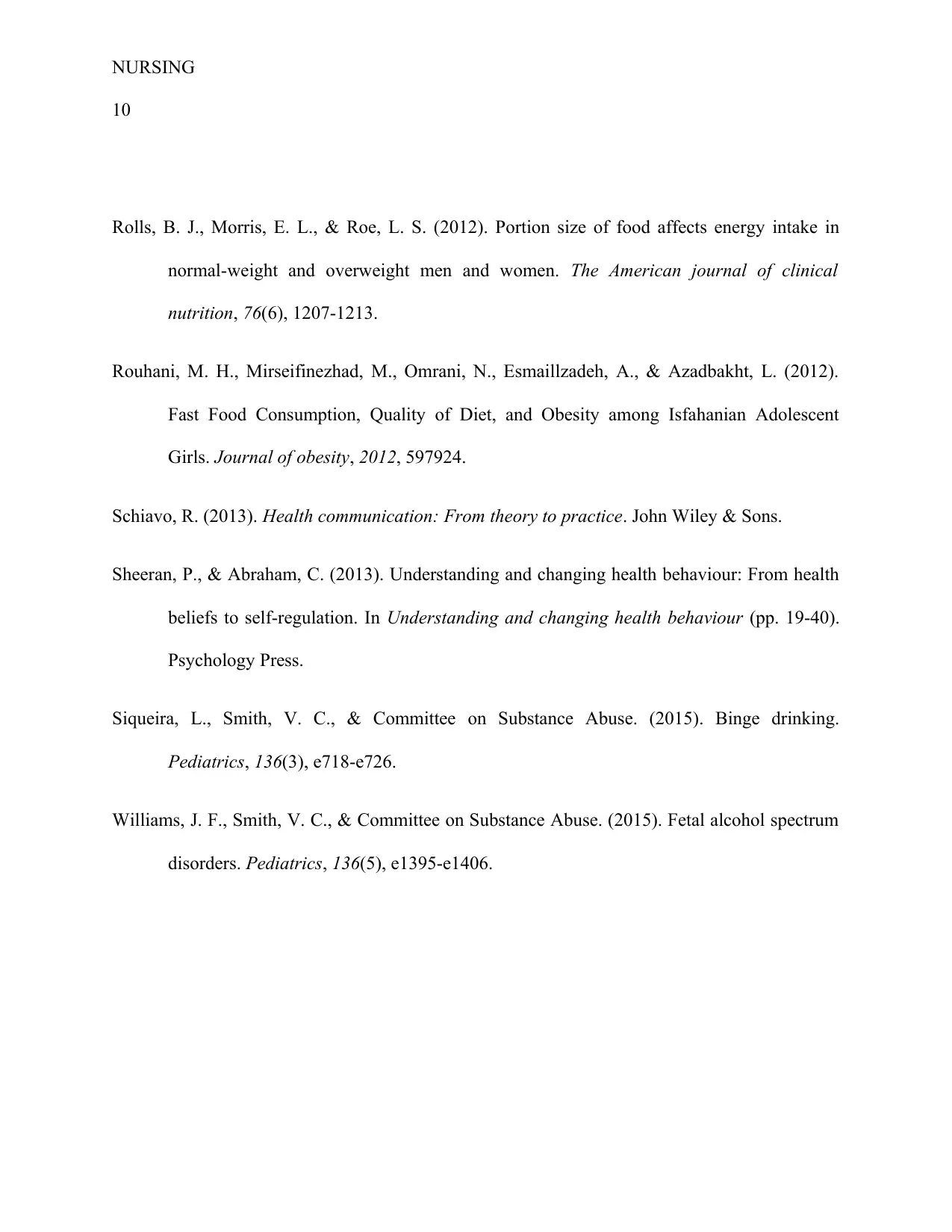
NURSING
10
Rolls, B. J., Morris, E. L., & Roe, L. S. (2012). Portion size of food affects energy intake in
normal-weight and overweight men and women. The American journal of clinical
nutrition, 76(6), 1207-1213.
Rouhani, M. H., Mirseifinezhad, M., Omrani, N., Esmaillzadeh, A., & Azadbakht, L. (2012).
Fast Food Consumption, Quality of Diet, and Obesity among Isfahanian Adolescent
Girls. Journal of obesity, 2012, 597924.
Schiavo, R. (2013). Health communication: From theory to practice. John Wiley & Sons.
Sheeran, P., & Abraham, C. (2013). Understanding and changing health behaviour: From health
beliefs to self-regulation. In Understanding and changing health behaviour (pp. 19-40).
Psychology Press.
Siqueira, L., Smith, V. C., & Committee on Substance Abuse. (2015). Binge drinking.
Pediatrics, 136(3), e718-e726.
Williams, J. F., Smith, V. C., & Committee on Substance Abuse. (2015). Fetal alcohol spectrum
disorders. Pediatrics, 136(5), e1395-e1406.
10
Rolls, B. J., Morris, E. L., & Roe, L. S. (2012). Portion size of food affects energy intake in
normal-weight and overweight men and women. The American journal of clinical
nutrition, 76(6), 1207-1213.
Rouhani, M. H., Mirseifinezhad, M., Omrani, N., Esmaillzadeh, A., & Azadbakht, L. (2012).
Fast Food Consumption, Quality of Diet, and Obesity among Isfahanian Adolescent
Girls. Journal of obesity, 2012, 597924.
Schiavo, R. (2013). Health communication: From theory to practice. John Wiley & Sons.
Sheeran, P., & Abraham, C. (2013). Understanding and changing health behaviour: From health
beliefs to self-regulation. In Understanding and changing health behaviour (pp. 19-40).
Psychology Press.
Siqueira, L., Smith, V. C., & Committee on Substance Abuse. (2015). Binge drinking.
Pediatrics, 136(3), e718-e726.
Williams, J. F., Smith, V. C., & Committee on Substance Abuse. (2015). Fetal alcohol spectrum
disorders. Pediatrics, 136(5), e1395-e1406.
1 out of 11
Related Documents
Your All-in-One AI-Powered Toolkit for Academic Success.
+13062052269
info@desklib.com
Available 24*7 on WhatsApp / Email
![[object Object]](/_next/static/media/star-bottom.7253800d.svg)
Unlock your academic potential
Copyright © 2020–2025 A2Z Services. All Rights Reserved. Developed and managed by ZUCOL.




